Lecture 1: Course Introduction and Overview
advertisement
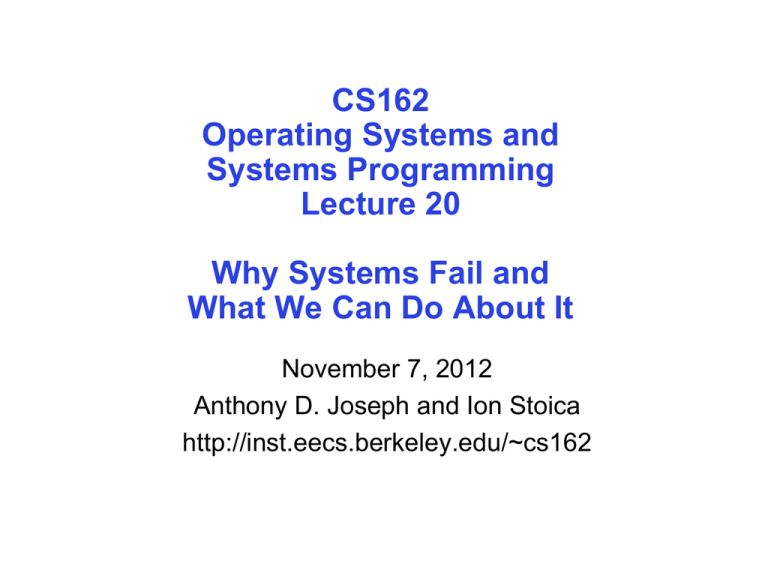
CS162
Operating Systems and
Systems Programming
Lecture 20
Why Systems Fail and
What We Can Do About It
November 7, 2012
Anthony D. Joseph and Ion Stoica
http://inst.eecs.berkeley.edu/~cs162
Goals for Today
• Definitions for Fault Tolerance
• Causes of system failures
• Fault Tolerance approaches
– HW- and SW-based Fault Tolerance, Datacenters,
Cloud, Geographic diversity
“You know you have a distributed system when the crash of
a computer you’ve never heard of stops you from getting
any work done.” —LESLIE LAMPORT
Note: Some slides and/or pictures in the following are adapted from slides
from a talk given by Jim Gray at UC Berkeley on November 9, 2000.
11/07/2012
Anthony D. Joseph and Ion Stoica CS162 ©UCB Fall 2012
Lec 20.2
Dependability: The 3 ITIES
• Reliability / Integrity:
does the right thing.
(Need large MTBF)
• Availability: does it now.
(Need small MTTR
MTBF+MTTR)
Integrity
Reliability
Security
Availability
• System Availability:
if 90% of terminals up & 99% of DB up?
(=> 89% of transactions are serviced on time)
MTBF or MTTF = Mean Time Between (To) Failure
MTTR = Mean Time To Repair
11/07/2012
Anthony D. Joseph and Ion Stoica CS162 ©UCB Fall 2012
Lec 20.3
Mean Time to Recovery
• Critical time as further failures can occur during recovery
• Total Outage duration (MTTR) =
Time to Detect
+ Time to Diagnose
+ Time to Decide
+ Time to Act
11/07/2012
(need good monitoring)
(need good docs/ops, best practices)
(need good org/leader, best practices)
(need good execution!)
Anthony D. Joseph and Ion Stoica CS162 ©UCB Fall 2012
Lec 20.4
Fault Tolerance versus
Disaster Tolerance
• Fault-Tolerance: mask local faults
– Redundant HW or SW
– RAID disks
– Uninterruptible Power Supplies
– Cluster Failover
• Disaster Tolerance: masks site failures
– Protects against fire, flood, sabotage,..
– Redundant system and service at
remote site(s)
– Use design diversity
11/07/2012
Anthony D. Joseph and Ion Stoica CS162 ©UCB Fall 2012
Lec 20.5
High Availability System Classes
Availability %
Downtime per year Downtime per month Downtime per week
90% (“one nine”)
36.5 days
72 hours
16.8 hours
99% (“two nines”)
3.65 days
7.20 hours
1.68 hours
99.9% (“three nines”) 8.76 hours
43.2 minutes
10.1 minutes
99.99% (“four nines”) 52.56 minutes
4.32 minutes
1.01 minutes
99.999% (“five nines”) 5.26 minutes
25.9 seconds
6.05 seconds
99.9999% (“six nines”) 31.5 seconds
2.59 seconds
0.605 seconds
GOAL: Class 6
Gmail, Hosted Exchange target 3 nines (unscheduled)
2010: Gmail (99.984), Exchange (>99.9)
UnAvailability ~ MTTR/MTBF
Can cut it by reducing MTTR or increasing MTBF
11/07/2012
Anthony D. Joseph and Ion Stoica CS162 ©UCB Fall 2012
Lec 20.6
Causal Factors for Unavailability
Lack of best practices for:
• Change control
• Monitoring of the relevant components
• Requirements and procurement
• Operations
• Avoidance of network failures, internal application
failures, and external services that fail
• Physical environment, and network redundancy
• Technical solution of backup, and process solution of
backup
• Physical location, infrastructure redundancy
• Storage architecture redundancy
11/07/2012
Ulrik Franke et al: Availability of enterprise IT systems - an expert-based Bayesian model
Lec 20.7
Anthony D. Joseph and Ion Stoica CS162 ©UCB Fall 2012
Case Studies - Tandem Trends
Reported MTBF by Component
Mean Time to S ystem Failure (years)
by Cause
450
400
maintenance
350
300
250
hardware
environment
200
operations
150
100
software
50
total
0
1985
SOFTWARE
HARDWARE
MAINTENANCE
OPERATIONS
ENVIRONMENT
SYSTEM
1987
1989
1985
1987
1990
2
29
45
99
142
53
91
162
171
214
33
310
409
136
346
Years
Years
Years
Years
Years
8
20
21
Years
Problem: Systematic Under-reporting
11/07/2012
Anthony D. Joseph and Ion Stoica CS162 ©UCB Fall 2012
Lec 20.8
Operations Failures
RAID Drive 1 failed!
Replace immediately
What went wrong??
11/07/2012
Anthony D. Joseph and Ion Stoica CS162 ©UCB Fall 2012
Lec 20.9
Operations Failures
RAID Drive 1 failed!
Replace immediately
11/07/2012
Anthony D. Joseph and Ion Stoica CS162 ©UCB Fall 2012
Lec 20.10
Cloud Computing Outages 2011
Vendor
When
Duration
What Happened & Why
Apple iPhone
4S Siri
November
2011
1 Day
Siri loses even the most basic functionality when Apples servers are down. Because Siri
depends on servers to do the heavy computing required for voice recognition, the service is
useless without that connection. Network outages caused the disruption according to Apple.
Blackberry
outage
October
2011
3 Days
Outage was caused by a hardware failure (core switch failure) that prompted a "ripple effect" in
RIM's systems. Users in Europe, Middle East, Africa, India, Brazil, China and Argentina initially
experienced email and message delays and complete outages and later the outages spread to
North America too. Main problem is message backlogs and the downtime produced a huge
queue of undelivered messages causing delays and traffic jams.
Google Docs
September
2011
1 Hour
Google Docs word collaboration application cramp, shutting out millions of users from their
document lists, documents, drawings and Apps Scripts. Outage was caused by a memory
management bug software engineers triggered in a change designed to “improve real time
collaboration within the document list.
Windows Live
services Hotmail &
SkyDrive
September
2011
3 Hours
Users did not have any data loss during the outage and the interruption was due to an issue in
Domain Name Service (DNS). Network traffic balancing tool had an update and the update did
not work properly which caused the issue.
Amazon’s EC2
cloud &
August
2011
1-2 days
Transformer exploded and caught fire near datacenter that resulted in power outage due to
generator failure. Power back up systems at both the data centers failed causing power
outages. Transformer explosion was caused by lightening strike but disputed by local utility
provider.
Microsoft’s
BPOS
August
2011
1-2 days
Transformer exploded and caught fire near datacenter that resulted in power outage due to
generator failure. Power back up systems at both the data centers failed causing power
outages. Transformer explosion was caused by lightening strike but disputed by local utility
provider.
From: http://analysiscasestudy.blogspot.com/
11/07/2012
Anthony D. Joseph and Ion Stoica CS162 ©UCB Fall 2012
Lec 20.11
Fault Model
• Assume failures are independent*
So, single fault tolerance is a big win
• Hardware fails fast (blue-screen, panic, …)
• Software fails-fast (or stops responding/hangs)
• Software often repaired by reboot:
– Heisenbugs – Works On Retry
– (Bohrbugs – Faults Again On Retry)
• Operations tasks: major source of outage
– Utility operations – UPS/generator maintenance
– Software upgrades, configuration changes
11/07/2012
Anthony D. Joseph and Ion Stoica CS162 ©UCB Fall 2012
Lec 20.12
Traditional Fault Tolerance Techniques
• Fail fast modules: work or stop
• Spare modules: yield instant repair time
• Process/Server pairs: Mask HW and SW faults
• Transactions: yields ACID semantics (simple fault
model)
11/07/2012
Anthony D. Joseph and Ion Stoica CS162 ©UCB Fall 2012
Lec 20.13
Fail-Fast is Good, but Repair is Needed
Fault
Lifecycle of a module
fail-fast gives
short fault latency
High Availability
is low UN-Availability
Unavailability ~
Return
Detect
X
X
Repair
MTTR
MTBF
Improving either MTTR or MTBF gives benefit
Simple redundancy does not help much (can actually hurt!)
11/07/2012
Anthony D. Joseph and Ion Stoica CS162 ©UCB Fall 2012
Lec 20.14
Hardware Reliability/Availability
(how to make HW fail fast)
Duplex module with output comparator:
MTBF/2
MTBF/2
MTBF/1
2
1
0
work
work
work
Worse MBTF from
simple redundancy!
Fail-Fast: fail if either fails (e.g., duplexed CPUs)
1.5 * MTBF
MTBF/2
The Airplane Rule:
MTBF/1
2
1
0
work
work
work
A two-engine airplane has twice
as many engine problems as a
one engine plane
Fail-Soft: fail if both fail (e.g., disc, network,...)
11/07/2012
Anthony D. Joseph and Ion Stoica CS162 ©UCB Fall 2012
Lec 20.15
Add Repair: Gain 104 Improvement
104 * MTBF
MTBF/2
Adding repair puts module back
into service after a failure
Duplex Fail Soft + Repair
Equation: MTBF2/(2 * MTTR)
Yields > 104 year MTBF
11/07/2012
MTBF/1
2
1
0
work
work
work
MTTR
MTTR
1 Year MTBF modules
12-hour MTTR
Anthony D. Joseph and Ion Stoica CS162 ©UCB Fall 2012
Lec 20.16
5min Break
11/07/2012
Anthony D. Joseph and Ion Stoica CS162 ©UCB Fall 2012
Lec 20.17
Software Techniques:
Learning from Hardware
• Fault avoidance starts with a good and correct design
• After that – Software Fault Tolerance Techniques:
Modularity (isolation, fault containment)
Programming for Failures: Programming paradigms that
assume failures are common and hide them
Defensive Programming: Check parameters and data
N-Version Programming: N-different implementations
Auditors: Check data structures in background
Transactions: to clean up state after a failure
11/07/2012
Anthony D. Joseph and Ion Stoica CS162 ©UCB Fall 2012
Lec 20.18
Try&Catch Alone isn’t Fault Tolerance!
String filename = "/nosuchdir/myfilename";
try {
// Create the file
new File(filename).createNewFile();
}
catch (IOException e) {
// Print out the exception that
occurred
System.out.println("Unable to create
file ("+filename+”): "+e.getMessage());
}
• Fail-Fast, but is this the desired behavior?
• Alternative behavior: (re)-create missing directory?
11/07/2012
Anthony D. Joseph and Ion Stoica CS162 ©UCB Fall 2012
Lec 20.19
Fail-Fast and High-Availability Execution
Process Pairs: Instant repair
Use Defensive programming to make a process fail-fast
Have separate backup process ready to “take over” if
primary faults
• SW fault is a Bohrbug no repair
“wait for the next release” or “get an emergency bug fix” or
“get a new vendor”
• SW fault is a Heisenbug restart process
“reboot and retry”
LOGICAL PROCESS = PROCESS PAIR
• Yields millisecond repair
times
SESSION
• Tolerates some HW faults
11/07/2012
Anthony D. Joseph and Ion Stoica CS162 ©UCB Fall 2012
PRIMARY
PROCESS
STATE
INFORMATION
BACKUP
PROCESS
Lec 20.20
Server System Pairs for High Availability
Primary
Local or wide area
Backup
• Programs, Data, Processes Replicated at 2+ sites
– Logical System Pair looks like a single system
– Backup receives transaction log
• If primary fails or operator switches, backup offers service
• What about workloads requiring more than one server?
11/07/2012
Anthony D. Joseph and Ion Stoica CS162 ©UCB Fall 2012
Lec 20.21
Apache ZooKeeper
Leader
Server
Server
Server
Server
Server
Server
Client Client Client Client Client Client Client
• Multiple servers require coordination
– Leader Election, Group Membership, Work Queues, Data
Sharding, Event Notifications, Config, and Cluster Mgmt
• Highly available, scalable, distributed coordination kernel
– Ordered updates and strong persistence guarantees
– Conditional updates (version), Watches for data changes
11/07/2012
Anthony D. Joseph and Ion Stoica CS162 ©UCB Fall 2012
Lec 20.22
Datacenter is new “server”
• What about even larger scale?
•
•
•
•
“Program” == Web search, email, map/GIS, …
“Computer” == 1000’s computers, storage, network
Warehouse-sized facilities and workloads
Built from less reliable components than traditional
datacenters
photos: Sun Microsystems & datacenterknowledge.com
11/07/2012
Anthony D. Joseph and Ion Stoica CS162 ©UCB Fall 2012
Lec 20.23
Many Commercial Alternatives
• The rise of Cloud Computing!
• “Inexpensive” virtual machinebased computing resources
– Instantaneous (minutes)
provisioning of replacement
computing resources
– Also highly scalable
• Competition driving down prices
• Easiest way to build a startup!
– Scale resources/costs as company
grows
11/07/2012
Anthony D. Joseph and Ion Stoica CS162 ©UCB Fall 2012
Lec 20.24
MapReduce: Programming for Failure
• First widely popular programming model for dataintensive apps on commodity clusters
• Published by Google in 2004
– Processes 20 PB of data / day
• Popularized by open-source Hadoop project
– 40,000 nodes at Yahoo!, 70 PB at Facebook
• Programming model
– Data type: key-value records
» Map function: (Kin, Vin) list(Kinter, Vinter)
» Reduce function: (Kinter, list(Vinter)) list(Kout, Vout)
11/07/2012
Anthony D. Joseph and Ion Stoica CS162 ©UCB Fall 2012
Lec 20.25
Word Count Execution
Input
the
quick
brown
fox
the fox
ate the
mouse
Map
Map
Shuffle & Sort
the, 1
brown, 1
fox, 1
Map
Map
Output
Reduce
brown, 2
fox, 2
how, 1
now, 1
the, 3
Reduce
ate, 1
cow, 1
mouse,
1
quick, 1
the, 1
fox, 1
the, 1
how, 1
now, 1
brown, 1
how
now
brown
cow
11/07/2012
Reduce
quick, 1
ate, 1
mouse, 1
cow, 1
Anthony D. Joseph and Ion Stoica CS162 ©UCB Fall 2012
Lec 20.26
Fault Tolerance in MapReduce
1. If a task crashes:
– Retry on another node
» OK for a map because it had no dependencies
» OK for reduce because map outputs are on disk
– If the same task repeatedly fails, fail the job
2. If a node crashes:
– Relaunch its current tasks on other nodes
– Relaunch any maps the node previously ran
» Necessary because their output files are lost
Tasks must be deterministic and side-effect-free
11/07/2012
Anthony D. Joseph and Ion Stoica CS162 ©UCB Fall 2012
Lec 20.27
Fault Tolerance in MapReduce
3. If a task is going slowly (straggler):
– Launch second copy of task on another node
– Take output of whichever copy finishes first
•Critical for performance in large clusters
•What about other distributed applications?
– Web applications, distributed services, …
– Often complex with many, many moving parts
– Interdependencies often hidden and/or unclear
11/07/2012
Anthony D. Joseph and Ion Stoica CS162 ©UCB Fall 2012
Lec 20.28
Introduce Controlled Chaos
• Best way to avoid failure is to fail constantly!
– John Ciancutti, Netflix
• Inject random failures into cloud by killing VMs
– Most times, nothing happens
– Occasional surprises
• April, 2011: EC2 failure brought down Reddit,
Foursquare, Quora (and many others)
– Netflix was unaffected thanks to
Chaos Monkey and replication
• Also apply to network and storage systems
http://techblog.netflix.com/2012/07/chaos-monkey-released-into-wild.html
11/07/2012
Anthony D. Joseph and Ion Stoica CS162 ©UCB Fall 2012
Lec 20.29
Add Geographic Diversity to
Reduce Single Points of Failure*
11/07/2012
Anthony D. Joseph and Ion Stoica CS162 ©UCB Fall 2012
Lec 20.30
Summary
• Focus on Reliability/Integrity and Availability
– Also, Security (see next two lectures)
• Use HW/SW FT to increase MTBF and reduce MTTR
– Build reliable systems from unreliable components
– Assume the unlikely is likely
– Leverage Chaos Monkey
• Make operations bulletproof: configuration changes,
upgrades, new feature deployment, …
• Apply replication at all levels (including globally)
11/07/2012
Anthony D. Joseph and Ion Stoica CS162 ©UCB Fall 2012
Lec 20.31
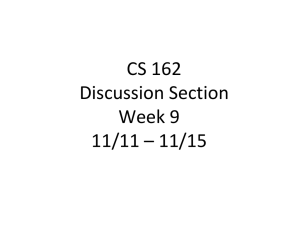
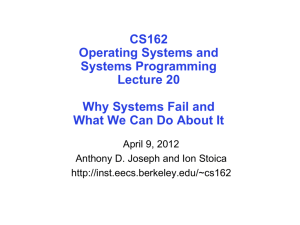
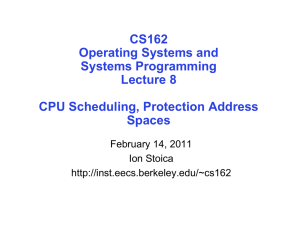
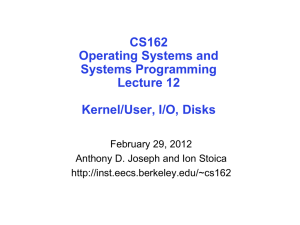
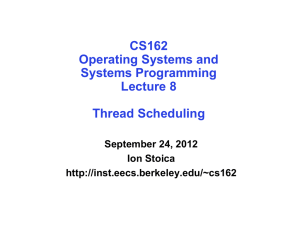
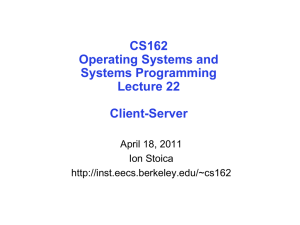
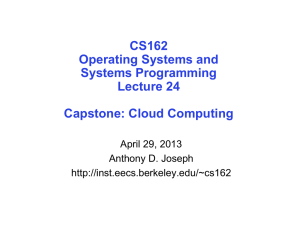
![Title of the Presentation Line 1 [36pt Calibri bold blue] Title of the](http://s2.studylib.net/store/data/005409852_1-2c69abc1cad256ea71f53622460b4508-300x300.png)



